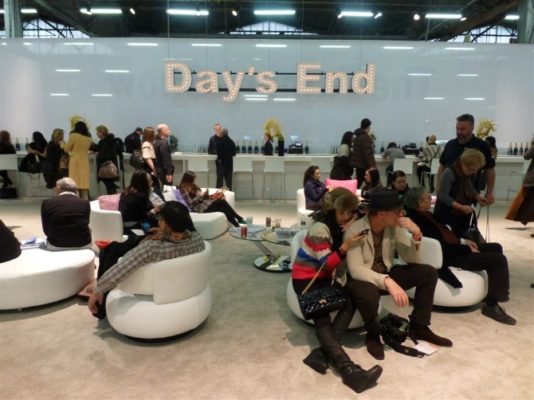Search
To search for an exact match, type the word or phrase you want in quotation marks.
A*DESK has been offering since 2002 contents about criticism and contemporary art. A*DESK has become consolidated thanks to all those who have believed in the project, all those who have followed us, debating, participating and collaborating. Many people have collaborated with A*DESK, and continue to do so. Their efforts, knowledge and belief in the project are what make it grow internationally. At A*DESK we have also generated work for over one hundred professionals in culture, from small collaborations with reviews and classes, to more prolonged and intense collaborations.
At A*DESK we believe in the need for free and universal access to culture and knowledge. We want to carry on being independent, remaining open to more ideas and opinions. If you believe in A*DESK, we need your backing to be able to continue. You can now participate in the project by supporting it. You can choose how much you want to contribute to the project.
You can decide how much you want to bring to the project.

Legend has it that the American Avant-garde began in 1913: until then only epic landscapes, between realism and impressionism, had been seen. That was the year that saw the injection of the virus of twentieth century art in what would come to be known as The Armory Show. So great was the scandal, the reaction to and reception of that exhibition, organized in the Armory of the 69th regiment, that over the years, it became an insurmountable reference when talking about art in the United States. So, this year the Armory paid homage to the Armory, that is to say, in the words of the billionaire mayor, “to New York as the center of the modern art world”.
5 days, 66.000 people, 8 simultaneous art fairs, a lot of zeros and numerous high heels traipsing round, the week of art fairs in New York. Until last year, with the arrival of Frieze, this was the week (along with the start of the season in September) when one just had to be in New York. A “must” for the long line of gallerists, collectors, advisors, curators, various dealers, directors of institutions and also, why not, artists.
I’m not sure what they see in fairs, what they find so attractive about this swarm of little stalls stuffed with paintings and screens, where the best thing one can do at the end of the day is vomit out the list of things seen, so as to make a bit of space in order not to dream one thing or another. I end up with dry eyes and a face deformed by the horror of what I find. Every time I step into a fair, I’m hit with a fear of terrorism, it’s such an easy target, on any opening night one could carry off large part of the establishment, erase in one fell swoop this gaggle of “beautiful people” that one only sees in fairs.
For a new collector, attending an art fair can be an interesting exercise, but few know what to buy; that’s where the advisors come in, who indicate, foresee, categorize and evaluate the impact of the investment. But the real ones prefer to go to Gagosian, to be lavished with client service, restaurant reservations, free delivery of the work… the quality of service that marks the highly treasured exclusivity and seduction of the tribal dance between buyer and seller.
The young money that comes mostly from technology industries or Wall Street is what marks the pace of the sales. To keep so many entrepreneurs happy is no easy task; they all want the same thing that they have seen in someone else’s house and here it comes with knobs on. Hirst, Hirst. Opie, Opie. The real explosion came in the eighties, when the figure of the wildly masculine stockbroker wanted everything, and now, so as to create an appearance and go up the social ladder. The very rise in the Dow Jones this week has excited the boys in the stock market, who see how the crisis that they began has barely affected corporate profits. The best art is expensive art, and there are still those who put the prices on the labels. The collectors collect artists like swap-cards, the gallerists collect collectors like index cards and the artists collect lovers like marbles. The fever of archiving, you yes, you no, you yes, you as well.
And the art is slowly codified, you see the same in Shanghai, Abu Dhabi, Miami or Moscow and it all serves to furnish empty mansions with ostentatious luxury, loaded with the bad taste of the filthy rich. All the art looks the same, a bit of color here, some digital images there, wall paper, photographs of performances, the use and abuse of textiles and weaving, screens and projections of everyday actions, installations of the sort “let’s take a risk so that they will talk about us on the news” and amidst all this lots of silicone, riding boots and oohs and ahs, and a flitting from flower to flower, like butterflies in spring.
I personally think that art is experience and in places like this the experience is null or nebulous; one that we are all familiar with, somehow or other repeating an exhausted and exhausting format. It is perhaps because of this that Isabelle Van Den Eynde, a cute Belgian with a past in finance and a gallery in Dubai, has darkened her space, handing out torches so that one can enter and see some drawings by Middle Eastern artists, in the manner of a freak show or an authentic fair attraction. Cheim&Read have blocked off their space with a wall made by Kounellis out of sewing machines, coal, steel and stones. What is more, here the experience is not art so much as the social life that develops around art, a relational form, not unlike the supermarket, where we bump into and greet the same old familiar people, where artistic value is confused with commercial value, and perfume and champagne are consumed in hectoliters.
On the other hand there are those who think that they can show everything on iPads, who create apps to inventory (Collectrium.com) or gaze at sculptures in augmented reality, like Google Glass. And they try to convince you that this is the fashion, that you download it right now on your iPhone that everything will be like this in the near future and that you are no longer going to need your Second Life profile.
Meanwhile, Duke Riley in the Armory gives away prints that everybody has made rubbing paper on a stone, and the Andy Warhol museum in Pittsburgh hands out free copies of copies of the Brillo Box, to fulfill the superstar’s desire to see people strolling around New York with the boxes. There are two signs with little lights, with pertinent letters of proposition by Peter Liversidge, and a strand of hair, where Rafael Lozano-Hemmer has written the word “devalued”, that we can see thanks to a Canadian electronic microscope. There are also those light objects with tromp l’oeil depth by Iván Navarro, the ironic paintings by David Kramer and hanging Christs by Kris Martin as well as the light installations by Jim Campbell.
This year the identity of the Armory has come from Liz Magic Laser, ex-Whitney Program, who has bathed her proposal in institutional critique, bringing together a group of marketing specialists, people from the art world and beyond, to decide the VIP levels and colors of the cards; in which is foreseen the umpteenth absorption of criticism by the market for just $2.000, which is what they have paid to the “Downtown emerging artist”. In ADAA, between Jean Arp and Egon Schiele is Fred Tomaselli and his miniature-painting-interventions on the covers of the New York Times. In Volta, there are paintings by the Cuban, Armando Mariño and the painting-cloth-cement pieces by the Israeli, Naomi Safran-Hon. Finally, in one of the corners of SCOPE there are the sculptures of Eugenio Merino.
All in all, we’ll just have to wait for Frieze and cross our fingers in the hope of seeing something more than a simple game of desire of the symbolic industry. And by the way, of Nude descending a staircase, not even a trace.

Xavier Acarín is fascinated with experience as the driving force of contemporary culture. He has worked in art centres and cultural organizations both in Barcelona and New York, focussing in particular on performance and installation.
"A desk is a dangerous place from which to watch the world" (John Le Carré)